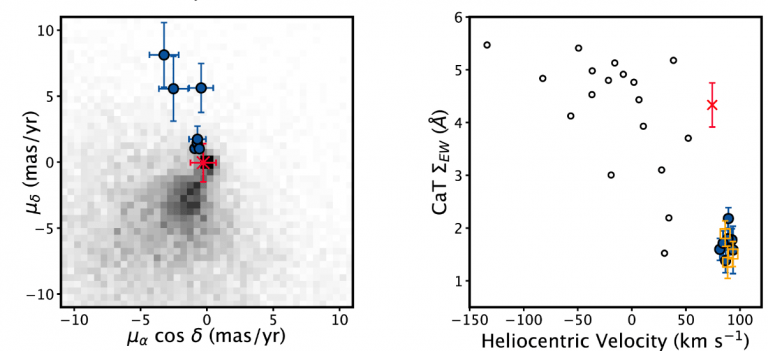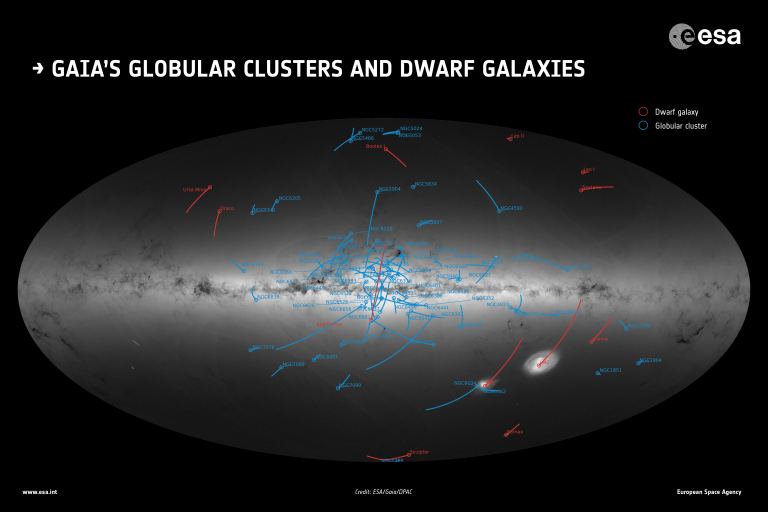The smallest and faintest satellite galaxy of the Milky Way has been discovered

The Milky Way has many satellite galaxies, most notably the Large and Small Magellanic Clouds. Both are visible to the naked eye from the southern hemisphere. Now astronomers have discovered another satellite, the smallest and dimmest ever discovered. It may be the galaxy with the highest dark matter content known.
The galaxy is called Ursa Major III / UNIONS 1 (UMa3/U1), and there are very few stars in it. Its luminosity is so low that until now it has gone unnoticed, although it is located next to us.
This discovery is reported in a new paper entitled “Ursa Major III/UNIONS 1: Darkest galaxy ever discovered?“The work was published in The Astrophysical Journal and was led by Simon Smith. Smith is a graduate student in astronomy at the University of Victoria, British Columbia, Canada.
“UMa3/U1 is located in the constellation Ursa Major, where Ursa Major is located. Relatively speaking, it is in our cosmic backyard, about 30,000 light-years from the Sun,” Smith says. “Until now, UMa3/U1 could not be detected due to its extremely low luminosity.”
There are only about 60 stars in UMa3/U1, which hardly allows it to be considered a galaxy. There are star clusters with many members. In fact, in terms of the number of stars, this tiny galaxy is more consistent with an open cluster.
The tiny galaxy contains stars more than 10 billion years old and is only 10 light years across, which is very small for a galaxy. Its mass is also small for a galaxy – only 16 times the mass of the Sun and 15 times less than the mass of the faintest possible dwarf galaxy. These small numbers would be more appropriate for a globular cluster, but the object could still be a galaxy due to the presence of dark matter.
Although some star clusters are more massive than this dwarf galaxy, they are not galaxies. Astronomers believe that globular clusters are dominated by processes associated with ordinary, baryonic matter. The mass of super-faint galaxies like this is many orders of magnitude greater than the total mass of their stars. “Therefore, within the framework of the Lambda-CDM (Lambda Cold Dark Matter) cosmological theory, dwarf galaxies are considered to be at the center of their own dark matter halos,” the study says. Astrophysicists believe that dark matter halos explain all this mass that globules and other star clusters lack.
The tiny galaxy was first spotted by the Ultraviolet Near Infrared Optical Northern Survey (UNIONS) project on the Canada France Hawaii Telescope (CFHT) and Panoramic Survey Telescope and Rapid Response System (Pan-STARRS) located in Hawaii. After discovering the star, the researchers studied it in more detail using the Keck Observatory's Deep Imaging Multi-Object Spectrograph (DEIMOS). These observations confirmed that the stars are gravitationally bound, which means they must be either in a cluster or in a tiny galaxy.

The small number of stars in the galaxy would make anyone doubt that it can rightfully be called a galaxy. Even researchers doubted this.
“UMa3/U1 has so few stars that one wonders whether it is simply a random collection of similar stars. Keck was instrumental in showing that this was not the case,” said study co-author Marla Geha, professor of astronomy and physics from Yale University. “Our DEIMOS measurements clearly show that all stars move through space at very similar speeds and appear to have similar chemical compositions.”

Astronomers are trying to understand dwarf galaxies and their dark matter. For example, diagnostic methods used by astronomers, such as stellar mass and metallicity, suggest that they are more like star clusters than galaxies. In addition, in terms of their observed properties, they occupy a middle position between clusters and dwarf galaxies.
There are many uncertainties when it comes to UMa3/U1. Somehow this association of stars has remained unchanged for a long time. At such a low stellar mass, this group should have already broken up into pieces, and its members would have dissolved into the larger population of the Milky Way. The fact that it's still together is intriguing evidence that dark matter is involved.
“It's exciting that the preliminary dispersion of stellar velocities in the system could support the conclusion that UMa3/U1 is a dark matter-dominated galaxy, and we hope to thoroughly explore this possibility with additional observations at Keck,” said Yale graduate student Will Cerney , second author of the study.
“The object is so small that its long-term survival is surprising. One would expect that severe tidal forces from the Milky Way's disk would have already torn the system apart without leaving any noticeable remnants,” says Kearney. “The fact that the system remained intact leads to two equally interesting possibilities. Either UMa3/U1 is a tiny galaxy stabilized by a large amount of dark matter, or it is a star cluster that we saw at the right moment before its imminent death.”
If astrophysicists can confirm that there is dark matter in the galaxy, it will be very important. This will be further evidence in support of the cold dark matter model (CDM), the leading theory of dark matter and the Big Bang. CDM predicts that when the Milky Way formed, its gravity attracted a large number of dwarf galaxies, many more than have been discovered so far. If this is one of them, and if the others are as difficult to detect as UMa3/U1, then this would support the theory.
But for the researchers behind this discovery, it's not just about dark matter. They found something unusual that is difficult to detect. Are there other similar galaxies?

“Whether future observations confirm or refute the fact that this system contains large amounts of dark matter, we are very excited by the possibility that this object could be the tip of the iceberg – it could be the first example of a new class of extremely faint star systems that… have eluded detection until now,” Cerny says.
As for its origin, there are only two options. It either formed on the spot, or the Milky Way pulled it towards itself. Astronomers use metallicity and orbits to determine the origin of a dwarf galaxy, but in this case, none of the measurements showed that it formed in situ.
Only further observations will make it possible to determine its origin, but so far the authors are inclined to the version of accretion. “We favor a scenario in which UMa3/U1 was pulled into the Milky Way halo,” they write in their conclusion. This script also supports the Lambda-CDM model.
Her fate is also unclear. So far it has not been torn into pieces, which indicates the presence of dark matter in it. But if it doesn't have dark matter, then it may be on the verge of destruction. All we can do is wait and watch.
For now, the object has an uncertain past and an uncertain future. But no matter how you classify it, it is something new, and therefore an interesting problem. “This discovery could challenge our understanding of galaxy formation and perhaps even our definition of a galaxy,” says Smith.





